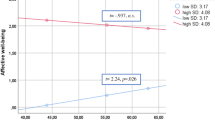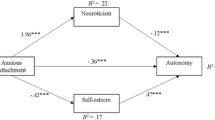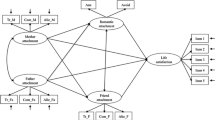Abstract
This study examined the popular notion that crushes or secondary attachments to celebrity figures are an important aspect of self-concept development during adolescence. In a repeated measures design, 79 male and female 5th, 8th, and 11th graders and college sophomores completed a set of personality scales, first describing themselves and later, describing the favorite celebrity. Repeated measures multivariate analyses of variance (MANOVA) analysis of self-object congruence revealed no significant main or interaction effects for the type of attachment, gender, or age of subject. Significant within subject effects were obtained for the repeated measures factor (self-object congruence). Overall, students perceived their attachment objects to be more agentic, yet less expressive and emotionally vulnerable than themselves. MANOVA analyses indicated that males and older students perceived their attachment objects to be higher in agency than expressivity, whereas females and younger students perceived their attachment objects to be higher in expressivity than agency. These data indicate that the function served by secondary attachments in the development of self-concept may be quite similar for adolescent males and females.
Similar content being viewed by others
References
Benson, R. M. (1980). Narcissistic guardians: Developmental aspects of transitional objects, imaginary companions and career fantasies. Adolescent Psychiatry, 8, 47–89.
Boxer, A. M., Gershonson, H. P., & Offer, D. (1984). Historical time and social change in the adolescent experience. In D. Offer, E. Ostrov, & K. I. Howard (Eds.), New directions for mental health services: Patterns of adolescent self-image. San Francisco: Jossey-Bass.
Davidson, S. (1973). Feeding on dreams in a bubble gum culture. Atlantic Monthly, 232, 62–66.
Davis, M. (1968). Sex and the adolescent. New York: Dial Press.
Elkind, D. (1967). Egocentricism in adolescence. Child Development, 38, 1025–1034.
Elkind, D. (1980). Strategic interactions in early adolescence. In J. Adelson (Ed.), Handbook of adolescent psychology. New York: John Wiley & Sons.
Elkind, D. & Bowen, R. (1979). Imaginary audience behavior in children and adolescents. Developmental Psychology, 15, 38–44.
Erikson, E. (1950). Childhood and society. New York: Norton.
Erikson, E. (1968). Identity: Youth and Crisis. New York: W. W. Norton & Company.
Fraiberg, S. (1968). The magic years. New York: Scribner.
Freud, S. (1925). Three contributions to the sexual theory. Nervous and mental disease monograph series (No. 7). New York: Nervous and Mental Disease Publishing.
Fromm, A. (1967). Ability to love. New York: Farrar, Strass, & Giroux.
Gagnon, J. (1977). Human sexualities. Glenview, IL: Scott, Foresman.
Gilligan, C. (1982). In a different voice: Psychological theory and women's development. Cambridge, MA: Harvard University Press.
Hebdige, D. (1979). Subculture: The meaning of style. London: Methuen.
Klein, B. R. (1985). A child's imaginary companion: A transitional self. Clinical Social Work, 13, 272–282.
Landis, C. (1970). Sex in development. College Park, MD: McGrath.
Langfeldt, T. (1980). Child sexuality: Development and problems. In J. Samson (Ed.), Childhood and sexuality: Proceedings of the International Symposium. Montreal: Etudes Editions.
Manosevitz, M., Prentice, N. W., & Wilson, F. (1973). Individual family correlates of imaginary companions in preschool children. Developmental Psychology, 8, 72–79.
Marcia, J. E. (1966). Development and validation of ego identity status. Journal of Personality and Social Psychology, 3, 551–558.
Marcia, J. E. (1980). Identity in adolescence. In J. Adelson (Ed.), Handbook of adolescent psychology. New York. Wiley.
Matteson, D. (1975). Adolescence today: Sex roles and the search for identity. Homewood, IL: Dorsey Press.
Muus, R. E. (1980). Theories of adolescence (4th ed.). New York: Random House.
Reiff, A. J. (1961). Occupations and social status. New York: Free Press.
Somers, J. U., & Yawhey, T. D. (1984). Imaginary play companions: Contributions of creative and intellectual abilities of young children. Journal Creative Behavior, 18, 77–89.
Spence, J., & Helmreich, R. (1978). Masculinity and femininity: Their psychological dimension, correlates and antecedents. Austin: University of Texas Press.
Winnicott, D. W. (1965). The maturational processes and the facilitating environment. New York: International Universities Press.
Winnicott, D. W. (1971). Playing and reality. New York: Basic Books.
Author information
Authors and Affiliations
Additional information
This research was supported by a grant awarded to the second author (“Transitions in adolescence”) by the National Research Council. This paper is an expanded version of one presented at the biennial meeting of the Society for Research on Child Development, Baltimore, MD, April 26–28, 1987. The authors gratefully acknowledge the assistance of David Grimm and Paul Klaczynski in the collection and analysis of data presented here, and Sharon Foster for her comments on a previous version of the manuscript.
Rights and permissions
About this article
Cite this article
Adams-Price, C., Greene, A.L. Secondary attachments and adolescent self concept. Sex Roles 22, 187–198 (1990). https://doi.org/10.1007/BF00288191
Issue Date:
DOI: https://doi.org/10.1007/BF00288191




